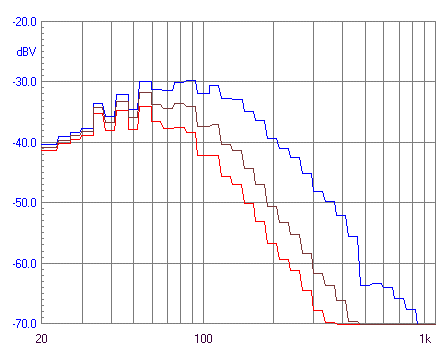 These are 1/6th
Octave RTA Measurements: The Blue is Frequency Knob at
Maximum
and Brown is Centre and Red is the
Minimum
Position. Please note carefully,
the are nearfield measurements and thus represents the 2Pi response.
This is not the Room Response
you will get at the listening position. The fact that the response does
not look flat down to 20 Hertz, it will in room.
The reason why this flat
response is attained is when you superimpose the Room Response curve
below. That shows that a Sub should not
have a flat 2Pi response.
These are 1/6th
Octave RTA Measurements: The Blue is Frequency Knob at
Maximum
and Brown is Centre and Red is the
Minimum
Position. Please note carefully,
the are nearfield measurements and thus represents the 2Pi response.
This is not the Room Response
you will get at the listening position. The fact that the response does
not look flat down to 20 Hertz, it will in room.
The reason why this flat
response is attained is when you superimpose the Room Response curve
below. That shows that a Sub should not
have a flat 2Pi response.
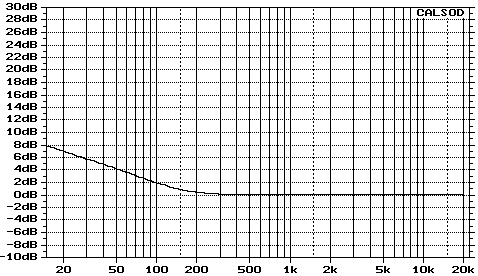 Here is an example where the
Sub has been inserted into a system:
Here is an example where the
Sub has been inserted into a system:
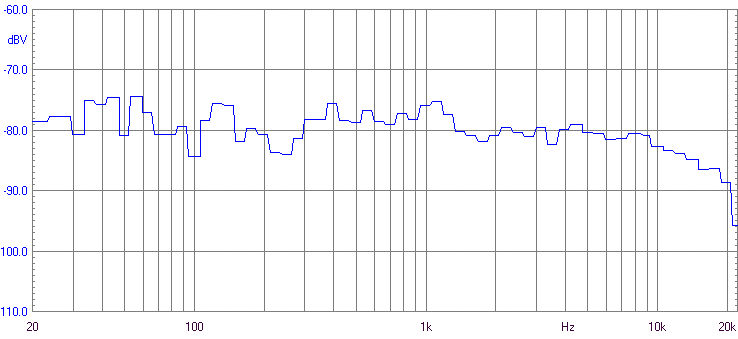 Now this may not exactly look
all that impressive, but it is deceiving. This is the actual Frequency
Response at the listener's position.
So it includes everything. It is not
the Frequency Response of the speakers. It includes all room modes,
otherwise the response would be much flatter.
This is 1/6th RTA, which is
four times the resolution of the usual 1/3rd RTA that you see
everywhere. Consequently it is a more severe and detailed measurement.
But note, the overall
response is flat down to 20 Hertz in room!
Now this may not exactly look
all that impressive, but it is deceiving. This is the actual Frequency
Response at the listener's position.
So it includes everything. It is not
the Frequency Response of the speakers. It includes all room modes,
otherwise the response would be much flatter.
This is 1/6th RTA, which is
four times the resolution of the usual 1/3rd RTA that you see
everywhere. Consequently it is a more severe and detailed measurement.
But note, the overall
response is flat down to 20 Hertz in room!

This is a 20 Hertz Sine Wave:

Keep this in mind, that these are 'Speaker' measurements, not
'Amplifier' measurements. This is an actual Acoustic Response
at 20 Hertz. Impressed? The above was taken nearfield and the V scale on the left is the actual output voltage of
the Test Microphone. The distortion is hardly noticeable and the wave form
is wonderfully clean. No sign of any doubling (where the driver outputs at
twice the frequency i.e. 40 Hertz).

This is the FFT Spectral Distortion
Measurement based on 40 Hertz:
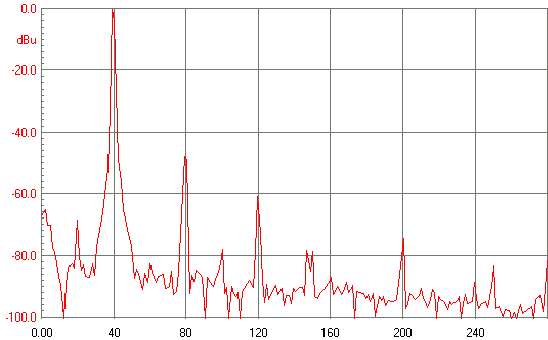
Total THD of Critical Q Sub is
0.6% approx.
This shows the second harmonic 80Hz distortion is -
48 dB, that's 0.4%. The third harmonic (120Hz) distortion
is - 61 dB, about 0.1% distortion. All harmonics above that are less than
0.1%. Total THD is approx. 0.6%. This is a very credible performance (almost incredible), again
easily matching Servo Subs.
The next example is a certain 'famous
brand' Sub:
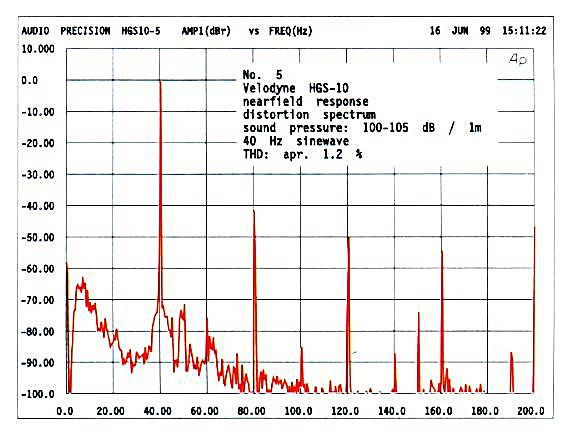
Total THD is 1.2% compared to
Critical Q Sub's 0.6% - this is no typo!
As a comparison this is a similar
test, based on 40Hz, on a highly respected Sub made by what some consider
the premier
maker of Servo-Controlled Subs. This highly spec'ed Sub measured - 42 dB at the 2nd harmonic 80Hz, about 0.8%. This is considered a good result - and it should be as
it is Servo-Controlled. But notice: The
higher order distortion is a lot higher, the 3rd harmonic is about 0.3%. I
don't think this is as good a
result The 3rd harmonic in our
Critical Q Sub of is less than 0.1% and the 4th is also under 0.1%. So our
Project is actually superior here.
Incidentally, when the total THD
figure is taken into account, our Critical Q Sub is 0.6%, whereas our
commercial Servo Sub measures 1.2%, no doubt due to the higher harmonic
distortion.
You can build
our Project Sub for about a quarter of the price. This proves
conclusively that we are easily attaining the performance of a high
quality Servo-Controlled Sub. I assure you that is sounds every bit as
good as it measures.

We have results here that shows
conclusively that our aim has been achieved, not just near enough but
every bit as good. This I believe is a landmark design.
I have been asked why this has not
been attempted before. Two reasons, such Low Q isn't considered
conventional, because it's a very lossy alignment. There has been a few
rare commercial full range speaker designs that have used Critical Q
alignments, and while they are very clean in the bass (very low
distortion and the best transient response of any box alignment) they also tend to be rather dry sounding . But this is more
likely because of premature roll-off when the Fb is about 50Hz or higher,
and hence lack of extension. We need an Fb of no more than 40Hz.
This comes to our second reason:
Finding a suitable driver. This superior Peerless driver gives us an Fb of
39Hz. It is not exposed to premature roll-off as it is used as a Sub and
it's the Sub Plate amplifier that controls the level of the Sub. The
lossy nature is also now negated by the high power amplifier and the
superior power handling of the chosen driver. What we are left with is the
very desirable low distortion, the incredible damping and transient speed of a
Critically Q Sub-Woofer.